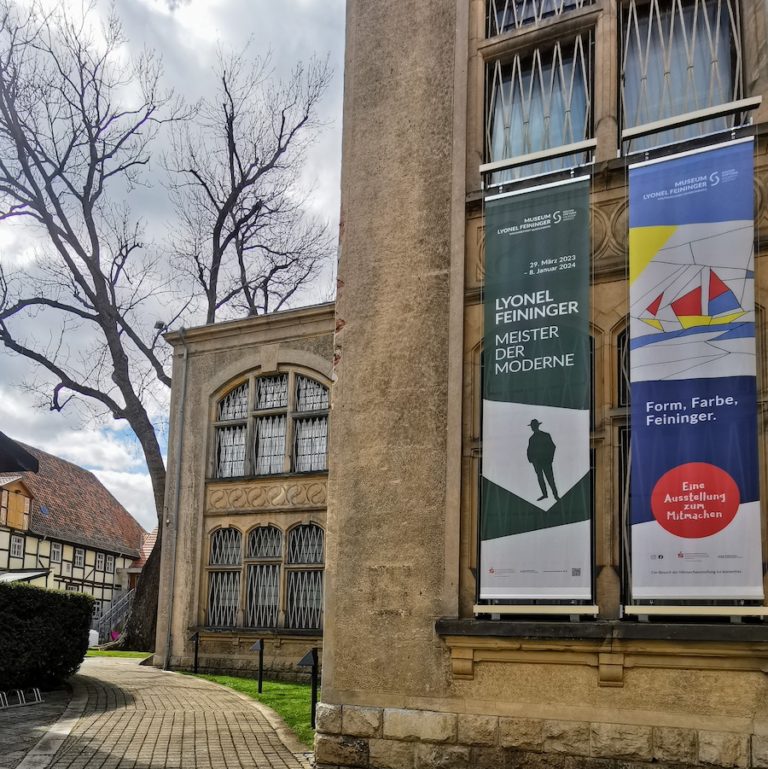
Workshops & events at Feininger in May & June 2025
Workshops & events for artists and art lovers will take place at the Museum Lyonel Feiniger in Quedlinburg in May & June 2025.
Be our guest in houses with history in the unique World Heritage town of Quedlinburg in the Harz Mountains. Our spacious holiday flats invite you to relax in historic surroundings. The variety of architectural monuments makes Quedlinburg a living book of history.
Experience the historic building structure and enjoy your holiday with individual living comfort in a special place. We also offer free gift vouchers. Please feel free to send us a message.
4 persons
and more
Free of charge
WLAN
Exterior
seat
The "Heinrich" holiday home is located in the small alleyways on the Schlossberg. The centre of the compact house is the friendly living-dining-kitchen with terrace. The sleeping areas with bathrooms for two people each are located on the ground floor and top floor. The house was designed for 4 guests. However, a sofa bed makes it easy to create two comfortable extra beds.
For the holiday home "Heinrich" we charge a basic price of 180,-€ / night.
2 persons
and more
Free of charge
WLAN
Pets
possible
Exterior
seat
The spacious "Adelheid" holiday flat is located above the carved threshold of the former white tannery. The bedroom faces the quiet courtyard and has access to the small, south-facing roof terrace. The street-facing living/dining room has direct access to the kitchen. The bathroom with bath and shower is located in the centre of the flat. The flat was designed for two guests; the sofa bed can be used to create two comfortable extra beds.
For the holiday flat "Adelheid" we charge a basic price of € 85,- / night.
2 persons
and more
Free of charge
WLAN
Exterior
seat
The friendly holiday flat "Anna Amalia", on the first floor of the former white tannery, has a bedroom facing the quiet courtyard. The living/dining room on the street side has direct access to the kitchen. The bathroom with bath and shower is located in the centre of the flat. The flat was designed for two guests; the sofa bed can be used to create two comfortable extra beds. The courtyard with the seating area by the Stiefelgraben invites you to sit by the water in the evening.
For the holiday flat "Anna Amalia" we charge a basic price of 82,-€ / night.
2 persons
and more
Free of charge
WLAN
In the "Maria Aurora" holiday flat, guests spend their holidays "above" the monument, so to speak. With a view of the town and the monastery, the bedroom faces the front. The kitchenette with dining area forms the centre of the flat. Guests can make themselves comfortable on the sofa facing the courtyard. The bathroom is the only other separate room. This flat is particularly suitable for cosy days for two.
For the holiday flat "Maria Aurora" we charge a basic price of 75,-€ / night.
6 persons
and more
Free of charge
WLAN
Pets
possible
Exterior
seat
The "Mathilde" holiday home offers space for many guests in the northern part of the prebendary house (built in 1713) of the former Heiliggeist Hospital in Quedlinburg. The flat with living-dining-kitchen, four bedrooms, two shower-bathrooms and outdoor seating area is designed for 7 guests. However, the sofa beds make it easy to create seven comfortable extra beds.
For the holiday home "Mathilde" we charge a basic price of 187,-€ / night.
6 persons
and more
Free of charge
WLAN
Pets
possible
Exterior
seat
The spacious holiday home "Dorothea" is located in the prebendary house (built in 1713) of the former Heiliggeist Hospital in Quedlinburg. The flat with living-dining-kitchen, three bedrooms, two shower-bathrooms and outdoor seating area is designed for 6 guests. However, the sofa beds make it easy to create four comfortable extra beds.
For the holiday home "Dorothea" we charge a basic price of 170,-€ / night.
4 persons
and more
Free of charge
WLAN
Exterior
seat
The "Otto" holiday home is located under the central decorative gable of the prebendary building of the former Heiliggeist Hospital. The flat with dining-kitchen, two bedrooms, spacious living area on the gallery, a shower-bathroom, extra WC and outdoor seating area is designed for 4 guests. The sofa beds can be used to create two comfortable extra beds if required.
For the holiday home "Otto" we charge a basic price of 130,-€ / night.
The gem of Quedlinburg is nestled in the beautiful landscape of the historic region of the northern Harz foreland. The World Heritage town with its unique cultural significance is the starting point for voyages of discovery into the past and the legendary nature of the Harz.

Workshops & events for artists and art lovers will take place at the Museum Lyonel Feiniger in Quedlinburg in May & June 2025.

Hans Ticha retrospective at the Lyonel Feininger Museum Quedlinburg until 8 September 2025

The Lyonel Feiniger Museum is a jewel in Quedlinburg's museum landscape. It houses the largest collection of graphic works by the Bauhaus master.